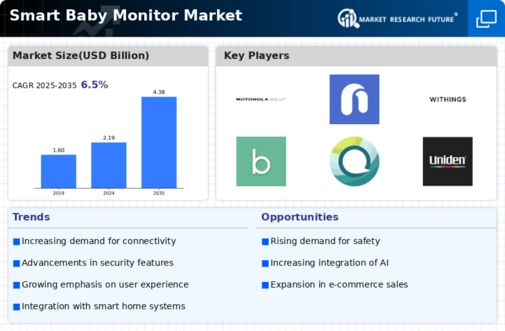Market Growth Projections
The Global Smart Baby Monitor Market Industry is poised for substantial growth, with projections indicating a market value of 2.19 USD Billion in 2024 and an anticipated increase to 4.38 USD Billion by 2035. This growth reflects a compound annual growth rate (CAGR) of 6.5% from 2025 to 2035, underscoring the increasing adoption of smart baby monitors among parents worldwide. The market's expansion is driven by various factors, including technological advancements, rising disposable incomes, and growing awareness of child safety, all contributing to a favorable environment for investment and innovation.
Rising Parental Awareness
In the Global Smart Baby Monitor Market Industry, rising parental awareness regarding child safety and health is a significant driver. Parents are increasingly informed about the benefits of using smart baby monitors, which can provide real-time alerts for various conditions, such as temperature changes or unusual sounds. This heightened awareness encourages parents to invest in smart monitoring solutions that offer peace of mind. As a result, the market is expected to grow steadily, with projections indicating a value of 4.38 USD Billion by 2035, highlighting the importance of safety in parenting.
Technological Advancements
The Global Smart Baby Monitor Market Industry is experiencing rapid growth due to continuous technological advancements. Features such as high-definition video streaming, two-way audio communication, and smartphone integration enhance user experience and convenience. For instance, many monitors now offer Wi-Fi connectivity, enabling parents to monitor their infants remotely via mobile applications. This trend is likely to drive the market's expansion, as parents increasingly seek innovative solutions for child monitoring. The market is projected to reach 2.19 USD Billion in 2024, reflecting a growing demand for advanced baby monitoring technologies.
Increased Disposable Income
The Global Smart Baby Monitor Market Industry is positively influenced by rising disposable incomes among families. As economic conditions improve, parents are more willing to invest in premium baby monitoring solutions that offer advanced features. This trend is particularly evident in developing regions, where a growing middle class is prioritizing child safety and comfort. The increased purchasing power allows families to opt for high-quality smart monitors, which are often equipped with innovative functionalities. Consequently, the market is anticipated to grow at a CAGR of 6.5% from 2025 to 2035, driven by this economic shift.
Growing Demand for Remote Monitoring
The Global Smart Baby Monitor Market Industry is witnessing a surge in demand for remote monitoring solutions. As more parents return to work or engage in other activities, the need for reliable monitoring systems that can be accessed from anywhere becomes paramount. Smart baby monitors equipped with mobile applications allow parents to check on their infants in real-time, providing reassurance and flexibility. This trend is likely to contribute to the market's growth, as the convenience of remote access aligns with modern parenting needs and lifestyles, further solidifying the market's trajectory.
Integration of Smart Home Technology
The Global Smart Baby Monitor Market Industry is increasingly integrating with broader smart home technology ecosystems. Many smart baby monitors can now connect with other devices, such as smart speakers and home security systems, creating a cohesive home monitoring experience. This integration not only enhances functionality but also appeals to tech-savvy parents looking for seamless solutions. As the demand for interconnected devices grows, the smart baby monitor market is expected to benefit significantly, with projections indicating a robust growth trajectory in the coming years.






















